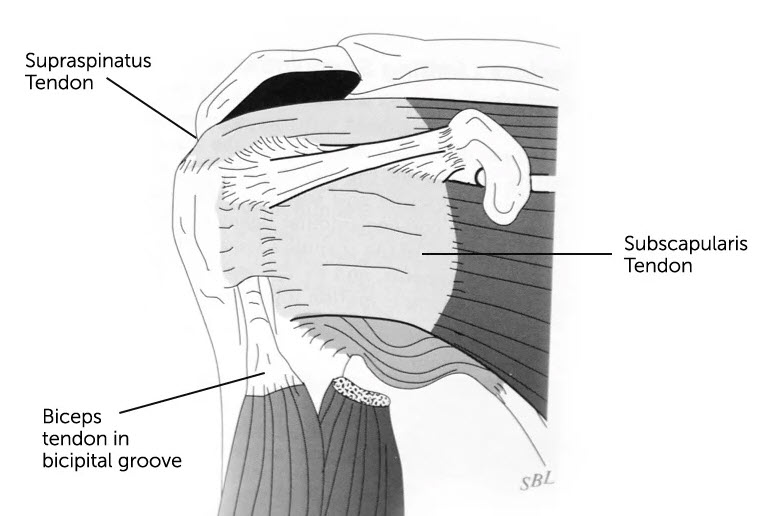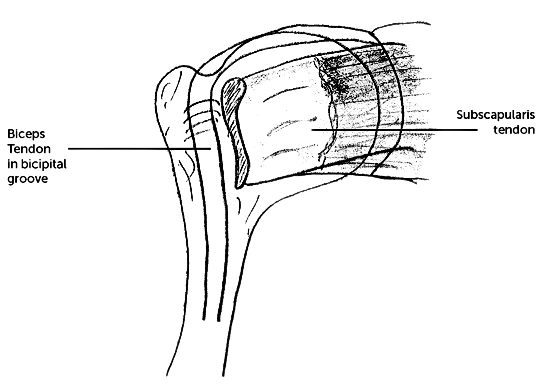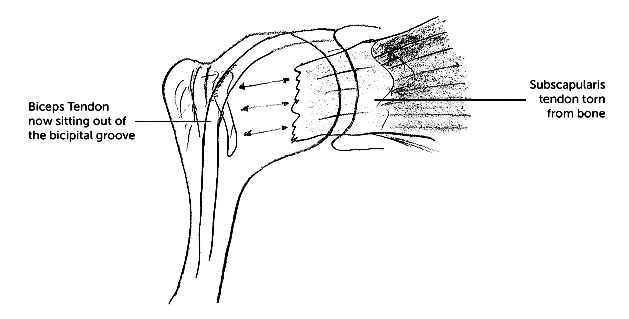Subscapularis Tears

Subscapularis tendon tears deserve a special mention as they can occur in isolation from the other tendons which make up the rotator cuff.
- Dr Duckworth
An injury to the subscapularis tendon is a common cause of shoulder weakness.

The subscapularis tendon is one of a group of tendons which collectively form the rotator cuff. Your shoulder has numerous muscles and tendons controlling movement and stability of the shoulder. Among these are the tendons of the rotator cuff. The rotator cuff is composed of four tendons that blend together to help stabilise and move the shoulder. The rotator cuff is the collective term for a group of tendons, which includes the supraspinatus, infraspinatus, teres minor, biceps and subscapularis. These tendons pass under a bony-ligamentous arch.
Loss of integrity of any of these tendons is a common cause of shoulder weakness. After an injury, the subscapularis tendon alone can be torn or it can tear along with other tendons around your shoulder such as the biceps tendon and the supraspinatus tendon.
Learn more about subscapularis repair surgery
What causes problems with the subscapularis tendon?
Tearing of the subscapularis usually results from trauma. The most common cause is a fall on an outstretched hand or if the arm is suddenly abducted away from the body as a result of a fall.
It is very unusual to get a full thickness degenerative tear of the subscapularis in isolation. One can however, get a small partial tear of the subscapularis tendon with time and age, and this then generally causes pain in your biceps tendon (which runs next to the subscapularis tendon) as it slips out of its groove and starts to rub. This is very similar to the analogy of a rope rubbing and starting to fray.

What are the symptoms?
The most common symptoms which cause a patient to seek medical advice are:
- Pain and weakness
- Difficulty putting your arm behind your back

How is a diagnosis made and what investigations are required?
In determining the diagnosis it is most important to take a thorough history from the patient and also to examine them to assess their range of motion and ability to use and raise their arm.
After this, one or more of the following tests may be ordered – a plain xray, ultrasound or MRI in order to assess the condition of the bones, tendons and ligaments. An MRI scan is the best test to show a subscapularis tear. It will also show if you have an associated problem with your biceps tendon.
How are these problems treated?
In patients who have an acute rupture of their subscapularis after a fall, surgical management is generally indicated to reattach the torn tendon back to the bone and thus restore function to the arm. The decision regarding surgery also depends on the age of the patient and their loss of function.
Generally patients with acute tears have weakness of internal rotation and of pushing their arm into their stomach. Pain down your arm may also be present due to associated problems with the biceps tendon.
The goal of the surgical repair of the subscapularis tendon, is to re-establish the connection between the torn tendon and the bone. If the tendon heals securely and durably to the bone, the force of the muscle can be effectively transmitted to the arm. This subsequently decreases pain and increases the strength of the arm.
For specific advice regarding subscapularis tears, please book an appointment with Dr David Duckworth on (02) 9806 3333
For appointments and enquiries, please phone (02) 9806 3333
8am to 5pm, Monday to Friday
© 2008-2024 Dr David Duckworth